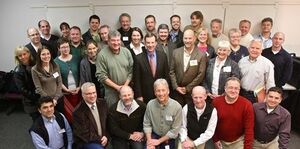
Difference between revisions of "Minimal Impact Design Standards (MIDS) workgroup"
m |
|||
| (5 intermediate revisions by the same user not shown) | |||
| Line 35: | Line 35: | ||
Stakeholder meetings were held October 7, 13, 19 and 29, 2009, in Brainerd, Duluth, Rochester and Plymouth. | Stakeholder meetings were held October 7, 13, 19 and 29, 2009, in Brainerd, Duluth, Rochester and Plymouth. | ||
| − | *Stakeholder meeting presentation | + | *[https://stormwater.pca.state.mn.us/index.php?title=File:P-gen3-08.pdf Stakeholder meeting presentation] |
*[[:File:P-gen3-08.pdf|MIDS stakeholder meeting notes]] | *[[:File:P-gen3-08.pdf|MIDS stakeholder meeting notes]] | ||
| Line 45: | Line 45: | ||
===Work group presentations=== | ===Work group presentations=== | ||
*June 18, 2010 meeting: | *June 18, 2010 meeting: | ||
| − | **MIDS and Antidegradation — Bill Cole | + | **[[File:Wq-rule3-39.pdf]]: MIDS and Antidegradation — Bill Cole |
*July 16, 2010 meeting: | *July 16, 2010 meeting: | ||
| − | **Runoff Hydrology 101 - Mike Isensee | + | **[https://stormwater.pca.state.mn.us/index.php?title=File:P-gen3-11a.pdf Runoff Hydrology 101] - Mike Isensee |
| − | **Volume Reduction Standards — Cliff Aichinger/Mark Doneaux | + | **[https://stormwater.pca.state.mn.us/index.php?title=File:P-gen3-11b.pdf Volume Reduction Standards] — Cliff Aichinger/Mark Doneaux |
*September 24, 2010 meeting: | *September 24, 2010 meeting: | ||
**[https://stormwater.pca.state.mn.us/index.php?title=File:P-gen3-12g.pdf Introduction to Initial Work Tasks — Barr Engineering] | **[https://stormwater.pca.state.mn.us/index.php?title=File:P-gen3-12g.pdf Introduction to Initial Work Tasks — Barr Engineering] | ||
| Line 144: | Line 144: | ||
**[https://stormwater.pca.state.mn.us/index.php?title=File:P-gen3-15j.pdf Incorporating Green Roofs into the MIDS calculator] | **[https://stormwater.pca.state.mn.us/index.php?title=File:P-gen3-15j.pdf Incorporating Green Roofs into the MIDS calculator] | ||
**[https://stormwater.pca.state.mn.us/index.php?title=File:P-gen3-15k.pdf MIDS Calculator GUI Demonstration] | **[https://stormwater.pca.state.mn.us/index.php?title=File:P-gen3-15k.pdf MIDS Calculator GUI Demonstration] | ||
| − | * | + | *[https://www.youtube.com/watch?v=9xpnJGGzYy4 Revolution of Minnesota Stormwater]: presentation by Jay Michels, Jay Riggs, Mike Isensee |
===Memorandums=== | ===Memorandums=== | ||
| Line 192: | Line 192: | ||
==Contact== | ==Contact== | ||
For more information about the MIDS project, contact Mike Trojan at 651-757-2790. | For more information about the MIDS project, contact Mike Trojan at 651-757-2790. | ||
| + | |||
| + | [[Category:Level 2 - General information, reference, tables, images, and archives/Archives]] | ||
Latest revision as of 14:14, 28 December 2022
Contents
Enhancing stormwater management in Minnesota
Stormwater management has evolved substantially during the past 20 years. Historically, the goal was to move water off the landscape quickly and reduce flooding concerns. Now we are focusing on keeping the raindrop where it falls and mimicking natural hydrology in order to minimize the amount of pollution reaching our lakes, rivers and streams, and to recharge our ground waters. In order to successfully do so, standards are needed to create consistency in design and performance.
In response to this need, and advanced by a diverse group of partners, the Minnesota Legislature allocated funds to “develop performance standards, design standards or other tools to enable and promote the implementation of low impact development and other stormwater management techniques.” (Minnesota Statutes 2009, section 115.03, subdivision 5c). Minimal Impact Design Standards (MIDS) represents the next generation of stormwater management and contains three main elements that address current challenges.
- A higher clean water performance goal for new development and redevelopment that will provide enhanced protection for Minnesota’s water resources.
- New modeling methods and credit calculations that will standardize the use of a range of “innovative” structural and nonstructural stormwater techniques.
- A credits system and ordinance package that will allow for increased flexibility and a streamlined approach to regulatory programs for developers and communities.
The development of Minimal Impact Design Standards is based on low impact development (LID) — an approach to storm water management that mimics a site’s natural hydrology as the landscape is developed. Using the low impact development approach, storm water is managed on site and the rate and volume of predevelopment storm water reaching receiving waters is unchanged. The calculation of predevelopment hydrology is based on native soil and vegetation. (Minnesota Statutes 2009, section 115.03, subdivision 5c).
Performance goal for new development
In April 2011, MIDS work group members agreed on a performance goal for new development: For new, nonlinear developments that create more than one acre of new impervious surface on sites without restrictions, stormwater runoff volumes will be controlled and the post-construction runoff volume shall be retained on site for 1.1 inches of runoff from impervious surfaces statewide.
Performance goal for redevelopment and linear
In June, 2013, the MIDS work group members agreed on a performance goal for redevelopment and linear.
Nonlinear redevelopment projects on site without restrictions that create one or more acres of new and/or fully reconstructed impervious surfaces shall capture and retain on site 1.1 inches of runoff from the new and/or fully reconstructed impervious surfaces.
Linear projects on sites without restrictions that create one acre or greater of new and/or fully reconstructed impervious surfaces, shall capture and retain the larger of the following:
- 0.55 inches of runoff from the new and fully reconstructed impervious surfaces
- 1.1 inches of runoff from the net increase in impervious area
Mill and overlay and other resurfacing activities are not considered fully reconstructed.
All projects shall first attempt to meet the volume reduction Performance Goal on site. However, if an applicant is unable to achieve the full Performance Goal due to site restrictions as attested by the local authority and documented by the applicant, the Flexible Treatment Options Approach shall be followed in the sequence below and through the MIDS Design Sequence Flow Chart.
Stakeholder input and meetings
In October 2009, we collected input from developers, municipal planners, public works departments, and decision makers to prioritize the most important structural and nonstructural best management practices that are needed for stormwater management. We will be relying upon this list of practices to develop work plans for consulting services.
Stakeholder meetings were held October 7, 13, 19 and 29, 2009, in Brainerd, Duluth, Rochester and Plymouth.
MIDS work group
In January 2010, a workgroup was formed under the auspices of the Minnesota Stormwater Steering Committee. Members of the MIDS workgroup will provide guidance and recommendations to the MPCA on the MIDs project. Co-chairs of the workgroup are Jay Riggs, Washington Conservation District and Jim Hafner, City of Blaine. Meeting notes and a list of workgroup members are noted below.
Work group presentations
- June 18, 2010 meeting:
- File:Wq-rule3-39.pdf: MIDS and Antidegradation — Bill Cole
- July 16, 2010 meeting:
- Runoff Hydrology 101 - Mike Isensee
- Volume Reduction Standards — Cliff Aichinger/Mark Doneaux
- September 24, 2010 meeting:
- November 19, 2010 meeting:
- December 17, 2010 meeting:
- January 21, 2011 meeting:
- February 4, 2011 meeting:
- February 18, 2011 meeting:
- March 18, 2011 meeting:
- April 15, 2011 meeting:
- May 20, 2011 meeting:
- June 17, 2011 meeting:
- October 21, 2011 meeting:
- November 18, 2011 meeting:
- December 16, 2011 meeting:
- January 2012 meeting:
- February 17, 2012 meeting:
- March 16, 2012 meeting:
- April 20, 2012
- May 18, 2012
- June 15, 2012
- August 17, 2012
- September 6, 2012: Iron Enhanced Sand Filter Presentation by Dr. John Gulliver
- October 19, 2012
- November 16, 2012
- January 18, 2013
- February 15, 2013
- March 15, 2013
- April 19, 2013
- May 17, 2013
- Revolution of Minnesota Stormwater: presentation by Jay Michels, Jay Riggs, Mike Isensee
Memorandums
- File:P-gen3-12a.pdf (12/17/10)
- File:P-gen3-12b.pdf (12/6/10)
- File:P-gen3-12o.pdf (6/11)
- File:P-gen3-12c.pdf (12/27/10)
- File:P-gen3-12d.pdf (12/11/10)
- File:P-gen3-12e.pdf (12/14/10)
- File:P-gen3-12f.pdf (12/14/10)
- File:P-gen3-12u.pdf (2/11/10) Final June, 2011
- File:P-gen3-12v.pdf (6/30/11) Final June, 2011
- File:Assessment MIDS performance goal alternatives.pdf (6/30/11) Final June, 2011
- File:P-gen3-13x.pdf (6/30/11)
MIDS 319 pilot project in the St. Croix basin
The St. Croix MIDS Pilot Community Project was established to help St. Croix Basin communities meet state water quality regulatory requirements and provide a real testing ground for the application of the new MIDS performance goals, credits and calculators, and the community assistance package. The Pilot Community Project involves regional and focused community assistance in the form of education, training, review and consultation services, and tools and resources such as model ordinances; all with the intent to apply the MIDS package. Education and training includes NEMO – Nonpoint source Education for Municipal Officials programming and Stormwater U – technical training for staff and consultants. Up to three pilot communities will receive free education, training, and consulting services to update plans, ordinances and codes to protect their local water resources and ultimately the St. Croix River. The MIDS Pilot Community Project is funded by a federal 319 Grant and managed through the Washington Conservation District with input from a Steering Committee.
- MIDS 319 Pilot Project in the St. Croix Basin Community Application
- Letter to Potential Communities from the MPCA (p-gen3-13j)
- "Upcoming opportunities to find out more" — NEMO What's Happening Web site
For more information, please contact Jay Riggs at the Washington Conservation District: 651-275-1136 Ext. 20.
Resources and associated studies
Minimal Impact Design Standards fact sheet
Performance of Low Impact Development Practices on Stormwater Pollutant Load Abatement, prepared for the MPCA by the University of Minnesota (2011).
- Final Report (p-gen3-13q)
- Infiltration Capacity of LID practices (p-gen3-13t)
- TMDL Demonstration Study (p-gen3-13r)
- Sorption and Release of Dissolved Pollutants via Bioretention Media (p-gen3-13s)
Minimal Impact Design Standards Partnership Legislative Report (2011)
Stormwater Design for High Intensity Redevelopment Projects (Chesapeake Stormwater Network) Managing the quality of stormwater runoff from redevelopment projects in highly urban watersheds can be complex and controversial. This Technical Bulletin (no. 5) seeks to reconcile the desire for improved urban runoff quality with the need for achieving smart growth in the Chesapeake Bay watershed.
Stormwater Reuse Guide (Metropolitan Council) This publication introduces effective alternative techniques for stormwater reuse for the purpose of reducing demand on supplies of potable water in the Twin Cities metropolitan area. Tailored for city planners, engineers, and green thinkers, the guide provides step-by-step instructions for bringing a stormwater reuse project from concept through assessment to implementation. [Metropolitan Council, 2011; ZIP archive (7.3Mb) includes publication and supporting documents]
Related links
- Low impact development
- Low impact development for businesses
- Minnesota Stormwater Manual
- MS4 program
- Stormwater Steering Committee
Contact
For more information about the MIDS project, contact Mike Trojan at 651-757-2790.
This page was last edited on 28 December 2022, at 14:14.

